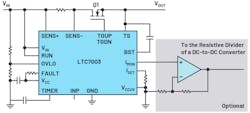Adding a Flexible Current Limit
Members can download this article in PDF format.
What you'll learn:
- The importance of current limiting.
- A flexible solution for adding current limiting.
In some power-management applications, precise current limiting is required. This is necessary either to protect the energy source—for example, if an intermediate circuit voltage requires overload protection so that it can reliably supply other system parts with energy—or to protect a load that can cause damage due to overcurrent in a fault condition.
In the search for a suitable dc-dc point-of-load (PoL) regulator to meet this requirement, you’ll find very few voltage converters with adjustable current limit on the market. While adjustable current limit is more often found on controller designs with external power switches, all integrated solutions seldomly offer such functionality. Also, adjustable current limits typically don’t have very high accuracy. On top of that, the current limiters in dc-dc converter ICs usually only limit the inductor current and not the input or output current of the power supply.
Such an integrated current limit is designed to protect “just” the switching regulator itself from destruction in a fault condition. The current limit lies above the nominally specified maximum output current and sometimes has a relatively low accuracy. This is adequate for protecting the switching regulator, but often not adequate for use as an adjustable current limiter (Fig. 1).
Add a Switch Driver
A flexible solution to this problem is to add an adjustable current limit via a component like the LTC7003, a high-side N-channel MOSFET static switch driver. Depending on the application, accuracies of approximately 15% can be achieved. Through its adjustable current limit and its current monitoring function, it’s well-suited for adding current limiting to common dc-dc converters.
Figure 2 shows the use of the LTC7003 current limiter for monitoring the output current of an ADP2370. The ADP2370 is a step-down dc-dc converter.
In general, high-side current-sense amplifiers also can be used to measure a small voltage drop via a current-sense resistor in the power path. They can measure currents with very high accuracy. However, with most of them, the permissible voltage difference between the two current-sensing connections is very small.
When such a general current-sense amplifier is used in a power supply that could suffer from short circuits due to the load, the voltage across the sense resistor can quickly go outside the permissible range. In this case, a driver like the LTC7003, which is permitted for use in a power supply, offers a solution.
Here, the LTC7003 is designed whereby a large voltage difference is permitted at the SENS inputs. It also offers the possibility of interrupting the power path through the optional N-channel MOSFET Q1 if the set current threshold is reached. Figure 3 shows a solution with an external N-channel MOSFET to interrupt the power path when reaching a set current threshold.
Through the IMON output, a voltage that’s proportional to the current flow through the sense resistor is provided. This voltage is in respect to the system ground and corresponds to the voltage across the sense resistor multiplied by a factor of 20. The voltage lies between 0 and 1.5 V.
That voltage can be used with an additional external op amp to feed into the feedback circuit of a switching regulator. In this way, the output voltage of the dc-dc converter can be reduced in proportion to the current level sensed by the LTC7003. This option is shown in Figure 3 in the gray box.



